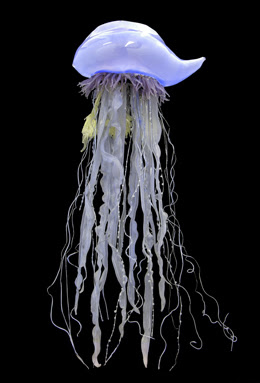From the 1870's to the turn of the century the worldwide demand for Natural History Museums, colleges and universities, and scientific investigation in the fields of botany, mycology and marine biology outpaced the availability of actual items to study. There were no real good ways of preserving these different life forms in a manner that could provide "hands-on" study and evaluation. Scientists in the field were collecting samples at a huge pace that were drawn and painted but no 3-D models existed until a Czechoslovakian glass maker and his family were persuaded to create these models.
The American educator behind this solution was Dr. George Lincoln Goodale, director of the Harvard University Botanical
Gardens. The Harvard collection ultimately ended up at nearly 4400 handmade, blown glass models. To read the complete story of the Blaschkas work with Goodale click here
 "Goodale searched for something that would be aesthetically pleasing,
scientifically accurate, and much appreciated by both botany students
and the general public. While peacocks can be stuffed and minerals can
be meticulously polished, presenting plants as attractive displays is
more problematic. Although lovely botanical models fashioned from
wax-covered silk or papier-mâché were available as teaching aids,
Goodale was impressed by the idea of using glass after he saw the
zoological models in the Museum of Comparative Zoology at Harvard, which
housed detailed glass models made by Leopold Blaschka and his son,
Rudolf. This allowed members of Harvard’s faculty to use replicas of
organisms to easily point out morphological features during lectures.
Goodale realized that the fragile zoological creatures were much like
fresh fruits and flowers that quickly decay and could never hold up as
an exhibition. He also knew that dried, pressed herbarium specimens and
color plates from botanical texts had a limited appeal".
"Goodale searched for something that would be aesthetically pleasing,
scientifically accurate, and much appreciated by both botany students
and the general public. While peacocks can be stuffed and minerals can
be meticulously polished, presenting plants as attractive displays is
more problematic. Although lovely botanical models fashioned from
wax-covered silk or papier-mâché were available as teaching aids,
Goodale was impressed by the idea of using glass after he saw the
zoological models in the Museum of Comparative Zoology at Harvard, which
housed detailed glass models made by Leopold Blaschka and his son,
Rudolf. This allowed members of Harvard’s faculty to use replicas of
organisms to easily point out morphological features during lectures.
Goodale realized that the fragile zoological creatures were much like
fresh fruits and flowers that quickly decay and could never hold up as
an exhibition. He also knew that dried, pressed herbarium specimens and
color plates from botanical texts had a limited appeal"."In 1886, Goodale traveled to Dresden, Germany, where the Blaschka family lived. Despite their initial resistance, Goodale ultimately persuaded the glass artists to accept a commission for a few plant models. The first shipment of these models was badly damaged by customs inspectors who hastily unpacked them, but the wafer-thin petals and leaves were convincingly lifelike. Goodale and his former Radcliffe College students, including Mary Lee Ware, believed that the Blaschkas’ skilled hands and extensive botanical knowledge could create a most remarkable exhibition".
"Leopold and Rudolf Blaschka agreed to a part-time, three-year contract. When it was time to renew the agreement in 1890, Goodale convinced Elizabeth Ware and her daughter, Mary, who had become the benefactors of the Glass Flowers collection, that a full-time, 10-year term would be more appropriate. The exhibition, which officially became a memorial to Charles Eliot Ware (Elizabeth’s husband and Mary’s father) on May 10, 1890, was titled The Ware Collection of Blaschka Glass Models of Plants. This collection represents the diversity of flora, with an emphasis on economically important plants that are used in everything from foods to medicines. The Blaschkas created three additional series of models, which show the life cycle of nonflowering plants such as ferns, mosses, and liverworts; insects and pollination; and blighted apples, pears, and other fruits".
By mid-1890, after they had made models of several hundred species to represent the major plant families, the Blaschkas had begun to exhaust their European sources. Although Rudolf was interested in undertaking a field expedition in North America, Goodale noted: “It seems worthwhile to induce young Mr. Blaschka to try his hand at reproduction of models from dry specimens, exactly as the botanical artists do. He would have to be shown how this sort of work is done, and if the experiment is a success, there will be no limit to the material at command, for we can procure the dried specimens in every stage of development.”
"This implies that the Blaschkas were used to, and preferred to have, living reference material. It also
suggests the complications involved in adding exotic or difficult-to-cultivate species to the collection. Judging from some of the flat-looking models, relying on herbarium specimens must have worked for a while. But it later became evident that Rudolf’s request would have to be considered seriously. This is indicated in a letter from Goodale to Elizabeth Ware on April 15, 1890, that outlined the conditions of the newly written contract. The Blaschkas offered to save enough money for Rudolf “to make a voyage to America in the winter of 1891–1892 in order to repair our broken models and make fresh studies.” But Goodale told them “that when the time came for his voyage I would see that he had enough for his expenses. He is anxious to visit South America and study some of [the] plants of great interest in their native forests, which are known to Science only by poor drawings."
After the Harvard project was completed, the family began to produce and sell all sorts of scientific models for Institutions all over the world. Here are examples.




















Hello! Do you have any photo's of the Blascka models of fungi?
ReplyDelete